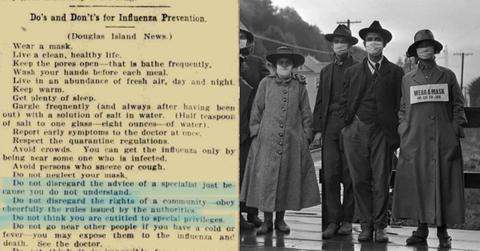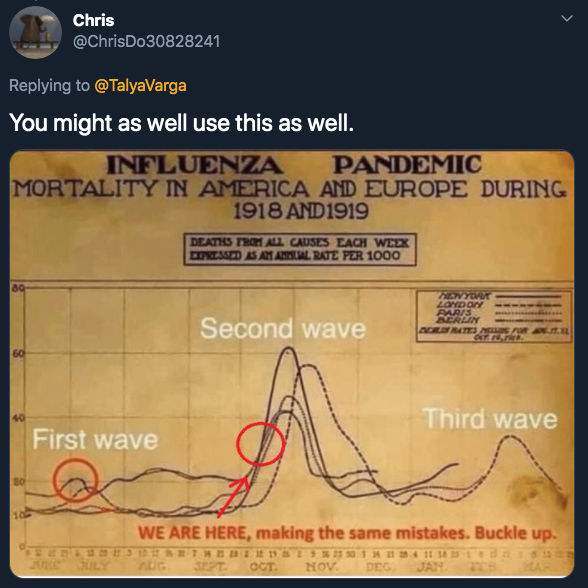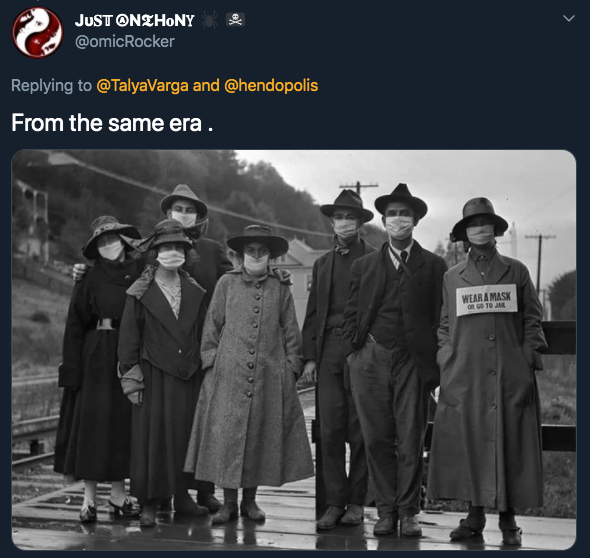This "Do's and Don't's" List From the 1918 Pandemic Proves We've Learned Absolutely Nothing in 100 Years
Published Aug. 12 2020, 6:34 a.m. ET

Almost exactly 100 years ago, the entire world faced a different pandemic: the Spanish Flu. The H1N1 virus spread throughout the world, and approximately 675,000 people in the U.S. died.
COVID-19 might be a different virus, but the spread of a deadly pandemic feels eerily similar for those who are aware of the Spanish Flu ordeal, which was thought to have reached American soil in 1918. Another positively uncanny fact is that people were having the same exact arguments way back then as they are now when it comes to wearing masks and social distancing. Just take a look at this list of "Do's and Don't's" for how to act during the pandemic of 1918.

Number one: WEAR A MASK. Sure, some of them (like gargling) are a little strange, but the gist is the same then as it is now; Wear a mask, wash your hands, "respect the quarantine regulations," "avoid crowds," and one more reminder... "DO NOT NEGLECT YOUR MASK."
But it's the highlighted section that really gets me and others. It's probably the reason this tweet has over 5,000 retweets and 10,000 likes. Even 100 years ago, we had to plead with each other to believe experts even if you don't understand the science, to heed the advice of scientists and other authorities on the matter, and to reject the idea that you are somehow "special" or exempt from these rules.
American exceptionalism was seemingly as much an issue then as it is now. And that's so disheartening. We had 100 years to improve our behavior and learn our lesson; it's literally one of the reasons we all learn history in school — to prevent ourselves from repeating the same mistake. But alas, here we are: Begging people not to go to football stadiums or concerts while staring at pictures of people gathering in huge crowds back in 1918.
Olga Jonas, a senior fellow at the Harvard Global Health Institute, told The Harvard Gazette, "There have been many books and papers written about the 1918 flu pandemic, and one of the main themes is how quickly it was forgotten, how fast it disappeared from the political discourse. I guess the lesson is to never forget because forgetting doesn’t lead to positive public health outcomes."
We can't let this pandemic go the way of the 1918 pandemic, which was largely unexamined in a lot of ways after it happened. Obviously, pandemics aren't so rare that we can't learn from the ones that have already happened.
There are a lot of similarities in the way the 1918 pandemic and COVID-19 have acted so far. But as Mari Webel and Megan Culler Freeman wrote for The Conversation, "COVID-19 has been hard to predict." Although we must learn from the 1918 pandemic, we can't assume that the trajectory of COVID-19 will follow the same trends.
We have to remain vigilant even if it seems like things are getting better. We have to continue to wear masks and social distance and wash our hands because those things work. It's only when we become too lax about those safety measures that infection rates get out of control.
Webel and Freeman write, "COVID-19 cases are unlikely to come with the predictability that discussions of influenza 'waves' in 1918-19 might suggest. Rather, as SARS-CoV-2 continues to circulate in nonimmune populations globally, physical distancing and mask-wearing will keep its spread in check and, ideally, keep infection and death rates steady."
We cannot control what the actual virus will do. But we can control how we react and how we treat each other. The actual pattern of the pandemic may differ from 100 years ago, but the things that we can do to mitigate the spread are the same. Wear a mask, wash your hands, social distance.
And we seem to be making largely the same mistakes when it comes to how we, as individuals part of a larger society, responded. It's way past time to learn how to be a considerate and responsible citizen, how to live to protect others as much as yourself. We didn't do it 100 years ago, and we're not doing now. But we can still learn from our mistakes.

